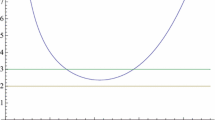Abstract
Removing a black hole conic singularity by means of Kruskal representation is equivalent to imposing extensibility on the Kasner–Fronsdal local isometric embedding of the corresponding black hole geometry. Allowing for globally non-trivial embeddings, living in Kaluza–Klein-like M 5 × S 1 (rather than in standard Minkowski M 6 ) and parametrized by some wave number k, extensibility can be achieved for apparently “forbidden” frequencies ω in the range ω 1 (k) ≤ ω ≤ ω 2 (k). As k → 0, ω 1, 2 (0) → ωH (e.g., ωH = 1/4M in the Schwarzschild case) such that the Hawking–Gibbons limit is fully recovered. The various Kruskal sheets are then viewed as slices of the Kaluza–Klein background. Euclidean k discreteness, dictated by imaginary time periodicity, is correlated with flux quantization of the underlying embedding gauge field.
Similar content being viewed by others
REFERENCES
D. Kramer, H. Stephani, E. Herlt, and M. MacCallum, in Exact Solutions of Einstein Field Equations (Cambridge University Press, Cambridge, 1980); H. F. Goenner, in General Relativity and Gravitation, A. Held, ed. (Plenum, New York, 1980), Vol. 1; M. D. Maia and E. M. Monte, gr-qc/9501031.
Y. Ne'eman and J. Rosen, Ann. Phys. 31, 391 (1965).
T. Regge and C. Teitelboim, Proceedings, Marcel Grossman Meeting (Oxford University Press, Oxford, 1977), pp. 77; S. Deser, F. A. E. Pirani, and D. C. Robinson, Phys. Rev. D 14, 3301 (1976).
R. Penrose, Rev. Mod. Phys. 37, 215 (1965); A. Friedman, Rev. Mod. Phys. 37, 201, (1965); J. Rosen, Rev. Mod. Phys. 37, 204 (1965); C. Frondsdal, Rev. Mod. Phys. 37, 221 (1965); D. W. Joseph, Rev. Mod. Phys. 37, 225 (1965); Y. Ne'eman, Rev. Mod. Phys. 37, 227 (1965); M. D. Maia, J. Math. Phys. 16, 1689 (1975).
V. A. Rubakov and M. E. Shaposhnikov, Phys. Lett. B 125, 136 (1983); M. Visser, Phys. Lett. B 159, 22 (1985).
M. Janet, Ann. Soc. Pol. Mater. 5 (1928); E. Cartan, Ann. Soc. Pol. Mater. 6, 1 (1928).
R. Greene, Mem. Am. Math. Soc. 97 (1970).
E. Kasner, Am. J. Math. 43, 126, 130 (1921).
C. Fronsdal, Phys. Rev. 116, 778 (1959).
M. D. Kruskal, Phys. Rev. 119, 1743 (1960); G. Szekeres, Pub. Math. Deb. 7, 285 (1960).
G. W. Gibbons and S. W. Hawking, Phys. Rev. D 15, 2752 (1977).
J. D. Bekenstein, Phys. Rev. D 7, 2333 (1973); S. W. Hawking, Commun. Math. Phys. 43, 199 (1975).
Author information
Authors and Affiliations
Rights and permissions
About this article
Cite this article
Davidson, A., Paz, U. Extensible Embeddings of Black-Hole Geometries. Foundations of Physics 30, 785–794 (2000). https://doi.org/10.1023/A:1003793128801
Issue Date:
DOI: https://doi.org/10.1023/A:1003793128801



